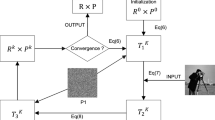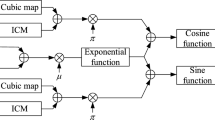Abstract
In this paper, we have proposed an asymmetric image encryption algorithm in the Chirp-Z domain using chaotic Tinkerbell map, DNA coding with biological mutation and phase truncation and phase reservation (PTFT) operation. Most of the DNA based encryption schemes involve XOR operator. The proposed asymmetric scheme uses biological mutation operator having more security features. The proposed cryptosystem is tested with various grayscale images and simulation results for Boy, Vegetable, and DICOM images are demonstrated in this paper. The proposed encryption algorithm is highly sensitive to the encryption parameters whereas DNA coding and PTFT provided an additional layer of security. The simulation result validates robustness of proposed image encryption algorithm against statistical attack, noise attack, chosen plaintext attack, special iterative attack for asymmetric schemes, and bruteforce attacks. The performance of proposed scheme is also compared with similar existing encryption algorithms. The results demonstrate that the proposed encryption algorithm can resist the existing cryptographic attacks.

















Similar content being viewed by others
Data availability
Data sharing does not apply to this article as no datasets were generated or analyzed during the current study.
Code availability
Not applicable.
References
Agoyi M, Çelebi E, Anbarjafari G (2015) A watermarking algorithm based on chirp z-transform, discrete wavelet transform, and singular value decomposition. SIViP 9(3):735–745. https://doi.org/10.1007/s11760-014-0624-9
Akkasaligar PT, Biradar S (2020) Selective medical image encryption using DNA cryptography. Information Security Journal: A Global Perspective 29(2):91–101. https://doi.org/10.1080/19393555.2020.1718248
Archana, Sachin, and P. Singh, “Cryptosystem based on triple random phase encoding with chaotic Henon map,” in Proceedings of International Conference on Data Science and Applications, vol. 148, K. Ray, K. C. Roy, S. K. Toshniwal, H. Sharma, and A. Bandyopadhyay, Eds. Singapore: Springer Singapore, 2021, pp. 73–84. doi: https://doi.org/10.1007/978-981-15-7561-7_5.
Archana, Sachin, and P. Singh. 2021.“Cascaded unequal modulus decomposition in Fresnel domain based cryptosystem to enhance the image security,” Optics and Lasers in Engineering, p. 12. https://doi.org/10.1016/j.optlaseng.2020.106399.
Cai J, Shen X, Lei M, Lin C, Dou S (2015) Asymmetric optical cryptosystem based on coherent superposition and equal modulus decomposition. Opt Lett 40(4):475. https://doi.org/10.1364/OL.40.000475
Chen H, Zhu L, Liu Z, Tanougast C, Liu F, Blondel W (2020) Optical single-channel color image asymmetric cryptosystem based on hyperchaotic system and random modulus decomposition in Gyrator domains. Opt Lasers Eng 124:05809. https://doi.org/10.1016/j.optlaseng.2019.105809
Chen J, Chen L, Zhou Y (2020) Cryptanalysis of a DNA-based image encryption scheme. Inf Sci 520:130–141. https://doi.org/10.1016/j.ins.2020.02.024
Chen H, Liu Z, Tanougast C, Liu F, Blondel W (2021) A novel chaos based optical cryptosystem for multiple images using DNA-blend and gyrator transform. Opt Lasers Eng 138:106448. https://doi.org/10.1016/j.optlaseng.2020.106448
Clelland CT, Risca V, Bancroft C (1999) Hiding messages in DNA microdots. Nature 399(6736):533–534. https://doi.org/10.1038/21092
Deng X (2015) Asymmetric optical cryptosystem based on coherent superposition and equal modulus decomposition: comment. Opt Lett 40(16):3913. https://doi.org/10.1364/OL.40.003913
Diaconu A-V (2016) Circular inter–intra pixels bit-level permutation and chaos-based image encryption. Inf Sci 355–356:314–327. https://doi.org/10.1016/j.ins.2015.10.027
Dou Y, Liu X, Fan H, and Li M. 2017. “Cryptanalysis of a DNA and chaos based image encryption algorithm,” Optik - International Journal for Light and Electron Optics, vol. 145. https://doi.org/10.1016/j.ijleo.2017.08.050.
El-Khamy SE, Mohamed AG (2021) An efficient DNA-inspired image encryption algorithm based on hyper-chaotic maps and wavelet fusion. Multimed Tools Appl. https://doi.org/10.1007/s11042-021-10527-6
Elshamy AM et al (2013) Optical image encryption based on chaotic Baker map and double random phase encoding. J Lightwave Technol 31(15):2533–2539. https://doi.org/10.1109/JLT.2013.2267891
Hermassi H, Belazi A, Rhouma R, Belghith SM (2014) Security analysis of an image encryption algorithm based on a DNA addition combining with chaotic maps. Multimed Tools Appl 72(3):2211–2224. https://doi.org/10.1007/s11042-013-1533-6
Jain A, Rajpal N (2016) A robust image encryption algorithm resistant to attacks using DNA and chaotic logistic maps. Multimed Tools Appl 75(10):5455–5472. https://doi.org/10.1007/s11042-015-2515-7
Javidi B (1997) Fault tolerance properties of a double phase encoding encryption technique. Opt Eng 36(4):992. https://doi.org/10.1117/1.601144
Javidi B, Nomura T (2000) Securing information by use of digital holography. Opt Lett 25(1):28. https://doi.org/10.1364/OL.25.000028
Kishk S, Javidi B (2002) Information hiding technique with double phase encoding. Appl Opt 41(26):5462. https://doi.org/10.1364/AO.41.005462
Krishna PR, Teja CVMS, R. D. S, and T. V, “A chaos based image encryption using Tinkerbell map functions,” in 2018 Second International Conference on Electronics, Communication and Aerospace Technology (ICECA). pp. 578–582. https://doi.org/10.1109/ICECA.2018.8474891.
Kumar R, Quan C (2019) Optical colour image encryption using spiral phase transform and chaotic pixel scrambling. J Mod Opt 66(7):776–785. https://doi.org/10.1080/09500340.2019.1572807
Kumar R, Bhaduri B, Hennelly B (2018) QR code-based non-linear image encryption using Shearlet transform and spiral phase transform. J Mod Opt 65(3):321–330. https://doi.org/10.1080/09500340.2017.1395486
Kumar J, Singh P, Yadav AK, Kumar A (2018) Asymmetric cryptosystem for phase images in fractional Fourier domain using LU-decomposition and Arnold transform. Procedia Computer Sci 132:1570–1577. https://doi.org/10.1016/j.procs.2018.05.121
Kumari E, Mukherjee S, Singh P, Kumar R (2020) Asymmetric color image encryption and compression based on discrete cosine transform in Fresnel domain. Results in Optics 1:100005. https://doi.org/10.1016/j.rio.2020.100005
Kumari E, Singh P, Mukherjee S, Purohit GN (2020) Analysis of triple random phase encoding cryptosystem in Fresnel domain. Results in Optics 1:100009. https://doi.org/10.1016/j.rio.2020.100009
Lai CS et al (2019) A robust correlation analysis framework for imbalanced and dichotomous data with uncertainty. Inf Sci 470:58–77. https://doi.org/10.1016/j.ins.2018.08.017
Lyda R, Hamrock J (2007) Using entropy analysis to find encrypted and packed malware. IEEE Secur Privacy Mag 5(2):40–45. https://doi.org/10.1109/MSP.2007.48
Mosso E, Bolognini N (2019) Dynamic multiple-image encryption based on chirp z-transform. J Opt 21(3):035704. https://doi.org/10.1088/2040-8986/ab015f
Mosso E, Suárez O, Bolognini N (2019) Asymmetric multiple-image encryption system based on a chirp z-transform. Appl Opt 58(21):5674. https://doi.org/10.1364/AO.58.005674
Peng X, Zhang P, Wei H, Yu B (2006) Known-plaintext attack on optical encryption based on double random phase keys. Opt Lett 31(8):1044. https://doi.org/10.1364/OL.31.001044
Peng X, Wei H, Zhang P (2006) Chosen-plaintext attack on lensless double-random phase encoding in the Fresnel domain. Opt Lett 31(22):3261. https://doi.org/10.1364/OL.31.003261
Rabiner LR, Schafer RW, Rader CM (1969) The chirp z-transform algorithm and its application. Bell Syst Tech J 48(5):1249–1292. https://doi.org/10.1002/j.1538-7305.1969.tb04268.x
Rakheja P, Vig R, Singh P (2019) Optical asymmetric watermarking using 4D hyperchaotic system and modified equal modulus decomposition in hybrid multi resolution wavelet domain. Optik 176:425–437. https://doi.org/10.1016/j.ijleo.2018.09.088
Rakheja P, Vig R, Singh P (2019) An asymmetric hybrid watermarking mechanism using hyperchaotic system and random decomposition in 2D Non-separable linear canonical domain. PINSA. https://doi.org/10.16943/ptinsa/2019/49590
Rakheja P, Vig R, Singh P, Kumar R (2019) An iris biometric protection scheme using 4D hyperchaotic system and modified equal modulus decomposition in hybrid multi resolution wavelet domain. Opt Quant Electron 51(6):204. https://doi.org/10.1007/s11082-019-1921-x
Refregier P, Javidi B (1995) Optical image encryption based on input plane and Fourier plane random encoding. Opt Lett 20(7):767. https://doi.org/10.1364/OL.20.000767
Sachin, Archana, and P. Singh. 2021. “Optical image encryption algorithm based on chaotic Tinkerbell map with random phase masks in Fourier domain,” in Proceedings of International Conference on Data Science and Applications, vol. 148, K. Ray, K. C. Roy, S. K. Toshniwal, H. Sharma, and A. Bandyopadhyay, Eds. Singapore: Springer Singapore, 2021, pp. 249–262. https://doi.org/10.1007/978-981-15-7561-7_20.
Sharma N, Saini I, Yadav A, and Singh P. 2017. “Phase image encryption based on 3D-Lorenz chaotic system and double random phase encoding.” 3D Res. vol. 8, no. 4, p. 39, https://doi.org/10.1007/s13319-017-0149-4.
Singh P, Yadav AK, Singh K (2017) Phase image encryption in the fractional Hartley domain using Arnold transform and singular value decomposition. Opt Lasers Eng 91:187–195. https://doi.org/10.1016/j.optlaseng.2016.11.022
Singh P, Yadav AK, Singh K, and Saini I. 2017. “Optical image encryption in the fractional Hartley domain, using Arnold transform and singular value decomposition,” presented at the AIP conference proceeding, 2017, p. 020017. https://doi.org/10.1063/1.4973267.
Singh P, Yadav AK, and Singh K. 2019 “Known-plaintext attack on cryptosystem based on fractional hartley transform using particle swarm optimization algorithm,” in Engineering Vibration, Communication and Information Processing, vol. 478, K. Ray, S. N. Sharan, S. Rawat, S. K. Jain, S. Srivastava, and A. Bandyopadhyay, Eds. Singapore: Springer Singapore, 2019, pp. 317–327. https://doi.org/10.1007/978-981-13-1642-5_29.
Su X, Li W, Hu H (2017) Cryptanalysis of a chaos-based image encryption scheme combining DNA coding and entropy. Multimed Tools Appl 76(12):14021–14033. https://doi.org/10.1007/s11042-016-3800-9
Sukhoy V, Stoytchev A (2019) Generalizing the inverse FFT off the unit circle. Sci Rep 9(1):14443. https://doi.org/10.1038/s41598-019-50234-9
Unnikrishnan G, Joseph J, Singh K (2000) Optical encryption by double-random phase encoding in the fractional Fourier domain. Opt Lett 25(12):887. https://doi.org/10.1364/OL.25.000887
Vijayalakshmi D, Nath MK (2020) Taxonomy of Performance Measures for Contrast Enhancement. Pattern Recognit. Image Anal 30(4):691–701. https://doi.org/10.1134/S1054661820040240
Vijayalakshmi D, Nath MK (2021) A Novel Contrast Enhancement Technique using Gradient-Based Joint Histogram Equalization. Circuits Syst Signal Process 40(8):3929–3967. https://doi.org/10.1007/s00034-021-01655-3
Vijayalakshmi D, Nath MK, Acharya OP (2020) A Comprehensive Survey on Image Contrast Enhancement Techniques in Spatial Domain. Sens Imaging 21(1):1–40. https://doi.org/10.1007/s11220-020-00305-3
Wang X, Li Y (2021) Chaotic image encryption algorithm based on hybrid multi-objective particle swarm optimization and DNA sequence. Opt Lasers Eng 137:10–6393. https://doi.org/10.1016/j.optlaseng.2020.106393
Wang T, Wang M (2020) Hyperchaotic image encryption algorithm based on bit-level permutation and DNA encoding. Opt Laser Technol 132:163550. https://doi.org/10.1016/j.optlastec.2020.106355
Wang J, Chen X, Zeng J, Wang Q-H, Hu Y (2019) Asymmetric cryptosystem using improved equal modulus decomposition in cylindrical diffraction domain. IEEE Access 7:66234–66241. https://doi.org/10.1109/ACCESS.2019.2917994
Wen H, Yu S, Lü J (2019) Breaking an image encryption algorithm based on DNA encoding and spatiotemporal chaos. Entropy 21(3):246. https://doi.org/10.3390/e21030246
Wu J, Liu W, Liu Z, Liu S (2015) Cryptanalysis of an asymmetric optical cryptosystem based on coherent superposition and equal modulus decomposition. Appl Opt 54(30):8921. https://doi.org/10.1364/AO.54.008921
Wu J, Liao X, Yang B (2018) Image encryption using 2D Hénon-Sine map and DNA approach. Signal Process 153:11–23. https://doi.org/10.1016/j.sigpro.2018.06.008
Yadav AK, Singh P, Singh K (2018) Cryptosystem based on devil’s vortex Fresnel lens in the fractional Hartley domain. J Opt 47(2):208–219. https://doi.org/10.1007/s12596-017-0435-9
Yuan S, Jiang T, Jing Z (2011) Bifurcation and chaos in the Tinkerbell map. Int J Bifurcation Chaos 21(11):3137–3156. https://doi.org/10.1142/S0218127411030581
Zhang Y (2020) Cryptanalyzing an image cryptosystem based on circular inter-intra pixels bit-level permutation. IEEE Access 8:94810–94816. https://doi.org/10.1109/ACCESS.2020.2995839
Zhang Q, Guo L, Wei X (Dec.2010) Image encryption using DNA addition combining with chaotic maps. Math Comput Model 52(11):2028–2035. https://doi.org/10.1016/j.mcm.2010.06.005
Zhen P, Zhao G, Min L, Jin X (2016) Chaos-based image encryption scheme combining DNA coding and entropy. Multimed Tools Appl 75(11):6303–6319. https://doi.org/10.1007/s11042-015-2573-x
Zhu S, Zhu C (2020) Secure image encryption algorithm based on hyperchaos and dynamic DNA coding. Entropy 22(7):772. https://doi.org/10.3390/e22070772
Funding
This work was funded by award reference number 09/1152(0012)/2019-EMR-1 from Council of Scientific & Industrial Research (CSIR), India, a premier national R&D organization. The contents of the publication are solely the responsibility of the authors and do not necessarily represent the official views of the Council of Scientific & Industrial Research.
Author information
Authors and Affiliations
Corresponding author
Ethics declarations
Conflict of interest
The authors have no conflict of interest concerning the publication of this manuscript.
Additional information
Publisher's Note
Springer Nature remains neutral with regard to jurisdictional claims in published maps and institutional affiliations.
Rights and permissions
Springer Nature or its licensor (e.g. a society or other partner) holds exclusive rights to this article under a publishing agreement with the author(s) or other rightsholder(s); author self-archiving of the accepted manuscript version of this article is solely governed by the terms of such publishing agreement and applicable law.
About this article
Cite this article
Sachin, Singh, P. Asymmetric Cryptosystem Based on Biological Mutation Operation in Chirp-Z Domain. Multimed Tools Appl 82, 42439–42463 (2023). https://doi.org/10.1007/s11042-023-15190-7
Received:
Revised:
Accepted:
Published:
Issue Date:
DOI: https://doi.org/10.1007/s11042-023-15190-7




